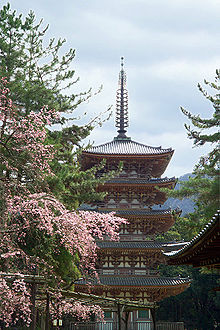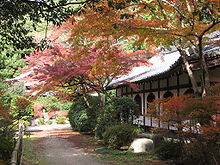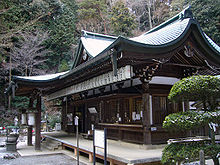- Daigo-ji
-
Daigo-ji (醍醐寺 Daigo-ji) is a Shingon Buddhist temple in Fushimi-ku, Kyoto, Japan. Its main devotion (honzon) is Yakushi. Daigo, literally "ghee," is used figuratively to mean "crème de la crème" and is a metaphor of the most profound part of Buddhist thoughts.[1]
Contents
History
Daigo-ji was founded in the early Heian period.[2] In 874, Rigen-daishi (Shōbō) founded the temple.
After having fallen ill and abdicated in 930, Emperor Daigo entered Buddhist priesthood at this temple. As a monk, he took the Buddhist name Hō-kongō; and shortly thereafter, died at the age of 46. He was buried in the temple, which is why his posthumous name was Daigo.[3]
National treasures
Several structures, including the kondō and the five-story pagoda, are National Treasures of Japan. The temple possesses 18 specifically designated national treasures, including the buildings and other works as well; and the temple holds several dozen important cultural assets. Wall paintings at the temple were the subject of academic research which earned the Imperial Prize of the Japan Academy in 1960.[4]
As part of the "Historic Monuments of Ancient Kyoto," it is included a World Heritage Site.
The five-story pagoda at Daigoji temple was built in 951 and is the oldest building in Kyoto. It was one of few buildings to survive the Onin War in the 15th century.
Garden
Autumn color from Acer palmatum (momiji) at Daigo-ji
More than seven centuries after its founding, Toyotomi Hideyoshi held a famous cherry-blossom-viewing party in 1598 at the Sambō-in sub-temple.[5]
The bright colors of maple leaves attract tourists and others in the Autumn season. Emperor Suzaku's mausoleum, known as Daigo no misasagi, is located near Daigo-ji.
Events
On August 24, 2008, the Juntei Kannon-dō at the top of the hill on the east of the temple burned. It stood in the Kami Daigo part of the temple. Kami Daigo is Number 11 in the 33 temples of the Kansai Kannon Pilgrimage. The structure dated from 1968.[6]
See also
- List of Buddhist temples in Kyoto
- List of National Treasures of Japan (temples)
- List of National Treasures of Japan (ancient documents)
- List of National Treasures of Japan (paintings)
- List of National Treasures of Japan (sculptures)
- List of National Treasures of Japan (writings)
- For an explanation of terms concerning Japanese Buddhism, Japanese Buddhist art, and Japanese Buddhist temple architecture, see the Glossary of Japanese Buddhism.
Notes
- ^ Soothill, W.E.; Hodous, Lewis (1937). A Dictionary of Chinese Buddhist Terms.
- ^ Ponsonby-Fane, Richard. (1956). Kyoto: The Old Capital of Japan, 794-1869, p. 115.
- ^ Titsingh, p. 134.
- ^ Japan Academy, Imperial Prize, "Wall-paintings in Daigo-ji Pagoda", May 18, 1960; retrieved 2011-08-15
- ^ Main, Alison. (2002). The Lure of the Japanese Garden, p. 27.
- ^ NHKニュース 京都 醍醐寺の観音堂が全焼 Retrieved August 24, 2008
References
- Brown, Delmer and Ichiro Ishida, eds. (1979). [ Jien, 1221], Gukanshō; "The Future and the Past: a translation and study of the 'Gukanshō,' an interpretive history of Japan written in 1219" translated from the Japanese and edited by Delmer M. Brown & Ichirō Ishida. Berkeley: University of California Press. ISBN 0-520-03460-0
- Ponsonby-Fane, Richard Arthur Brabazon. (1956). Kyoto: The Old Capital of Japan, 794-1869. Kyoto: The Ponsonby Memorial Society.
- Titsingh, Isaac. (1834). [Siyun-sai Rin-siyo/Hayashi Gahō, 1652]. Nipon o daï itsi ran; ou, Annales des empereurs du Japon. Paris: Oriental Translation Society of Great Britain and Ireland.
- Varley, H. Paul , ed. (1980). Kitabatake Chikafusa, 1359], Jinnō Shōtōki ("A Chronicle of Gods and Sovereigns: Jinnō Shōtōki of Kitabatake Chikafusa" translated by H. Paul Varley). New York: Columbia University Press. ISBN 0-231-04940-4
External links
Coordinates: 34°57′05″N 135°49′15″E / 34.95139°N 135.82083°E
Buddhism Buddhism portal Kyōto Daigo-ji · Ginkaku-ji1 · Kamigamo Shrine2 · Kinkaku-ji3 · Kiyomizu-dera · Koke-dera4 · Kōzan-ji · Nijō Castle · Ninna-ji · Nishi Honganji · Ryōan-ji · Shimogamo Shrine5 · Tenryū-ji · Tō-ji6
Uji Ōtsu 1 Jishō-ji 2 Kamowakeikazuchi Shrine 3 Rokuon-ji 4 Saihō-ji 5 Kamomioya Shrine 6 Kyōōgokoku-ji
Buddhist temples in Japan Japanese Buddhist architecture Architectonic elements Mon (gates) Buildings Chinjusha · chōzuya/temizuya · -dō · main hall (kon-dō, hon-dō, butsuden) · kuri · kyōzō or kyō-dō · shoinTō or Buttō (pagodas) Styles Others A-un · kenSchools and objects of worship Major schools Zen schools Nanto rokushū Objects of worship Amida Nyōrai · Benzaiten · Dainichi Nyorai · Jizō · Kannon · Marishi-ten · Shaka Nyorai · Shitennō (Four Kings) · Twelve Heavenly Generals (Jūni Shinshō) · Yakushi NyoraiOther elements Implements kei (ritual gong) · mokugyōOthers bussokuseki · butsudan · Glossary of Japanese Buddhism · Japanese Buddhist pantheon · jingū-ji · miyadera · saisenbakoCategories:- 874 establishments
- Religious organizations established in the 9th century
- Buddhist temples in Kyoto Prefecture
- Shingon Buddhism
- World Heritage Sites in Japan
- National Treasures of Japan
- Important Cultural Properties of Japan
- Japanese pagodas
Wikimedia Foundation. 2010.



